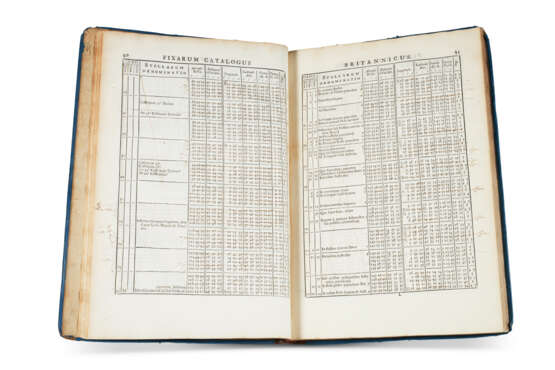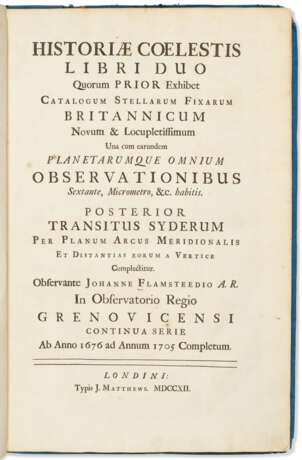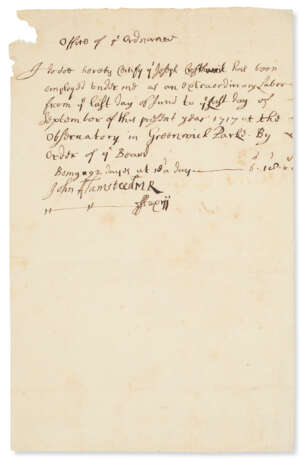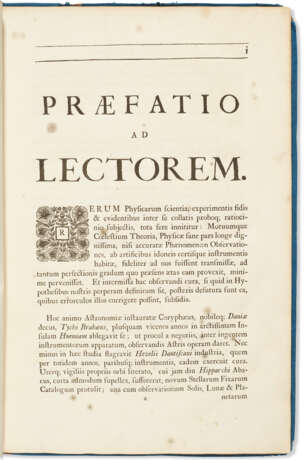ID 1360797
Lot 81 | Stellarum Fixarum Catologus Britannicus
Valeur estimée
$ 30 000 – 50 000
Flamsteed's own copy of the unauthorized star catalogue published by Halley and Newton, held back from the pyre on which Flamsteed burned the other 300 copies, and annotated on every page.
The unauthorized publication of Flamsteed's observations by Isaac Newton and Edmond Halley in 1712 is one of the most infamous episodes in astronomical history. As described by Owen Gingerich, "Newton was exceedingly anxious to get the Astronomer Royal's observations of the moon in order to check his lunar theory, but Flamsteed was extremely reluctant because he did not yet have final positions for the comparison stars on which the lunar positions depended. Finally, in his frustration, Newton managed to become head of the Visiting Committee for the Greenwich Observatory. Using his power, Newton demanded a manuscript copy of the observations, which Flamsteed gave him under seal. When Newton got publication funds from the nobility, he broke the seals and gave the star catalog to Halley for editing and publication, in 1712" (unpublished notes included with volume).
After the ascension of King George I and then the death of Newton’s patron, the Earl of Halifax, in 1715, the political tides turned in Flamsteed’s favor. By the spring of 1716, Flamsteed had taken physical possession of about 300 copies—all that remained after about 60 had been distributed. He extracted from these copies the portions which were done under his supervision (and printed before the end of 1707) and burned the rest, i.e. he burned the catalogue of fixed stars, Stellarum Fixarum Catologus Britannicus (the first part of Book 1) and the whole of Book 2.
The present volume comprises only the portions which Flamsteed otherwise burned in late April of 1716, in an act that he called a “sacrifice to TRUTH” in a letter to his former assistant and collaborator, Abraham Sharp. About five weeks after this act, Flamsteed again writes to Sharp and describes this very volume: “On Wednesday last in the evening My man delivered […] my Catalogue of the fixed stars as it is corrupted and spoyled by Dr Halley. All the faults are markd in the Margent […] you may perhaps find more errors than I have noted, if you doe pray keep a list of them and let me have a copy of it in good time. With it in the same cover are bound up his sorry abstracts of the planetary observations taken with my Murall arch, wherein he Numbers the stars according to his owne account, but no ways conformable to my own catalogue: he is as lazy and slothfull as he is Corrupt.” (2 June 1716).
Every page of the star catalogue (part 1 of book 1) has some annotation in the hand of Joseph Crosthwait, Flamsteed’s assistant and amanuensis. (Owen Gingerich identifies the hand by comparison with the relevant Greenwich observation manuscript book.) Halley’s star numbers and descriptions of star positions within constellations are all faithfully crossed out and there is copious movement of stars in and out of various assigned constellations. Ursa Major, for example, loses the majority of the 215 stars assigned to it to either Camelopardalis or Lynx (two 17th-century constellations sanctioned by Hevelius). A footnote on page 28 is ex'd out four times with the simple commentary: “falsum est.” Alan Cook, Edmond Halley’s biographer, refers to this volume as one of the three essential documents in understanding the difference between the unauthorized edition and the authorized one finally published in 1725, completed posthumously by both Sharp and Crosthwaite. See Willmoth, Flamsteed’s Stars (1997); Alan Cook, “Edmond Halley and John Flamsteed at the Royal Observatory”, pp.167-87; Owen Gingerich, “A Unique Copy of Flamsteed’s Historia Coelestis”, pp.189-97. Babson 329; ESTC T88901; Gingerich Rara astronomica 49.
Folio (386 x 257mm). Engraved dedication leaf and four engraved headpieces by Lud. du Guernier after Jacob Gibs and I.B. Catenaro. Text comprises part 1 of book 1: star catalogue, 60 pp.; and book 2, complete in 3 parts: observations of the planets, of the sun and moon, and of eclipses of the Jovian moons, 120 pp. (missing the middle text being book 1 parts 2-7 and the frontispiece, small hole/paper flaw in O2 & P2 with loss of a few characters, scattered small spots on preface leaves). 19th-century blue boards rebacked in modern calf to style (corners and board edges abraded). Provenance: John Flamsteed (annotations of Joseph Crosthwait, sent to:) – Abraham Sharp (see 2 June 1716 letter) – William Walker Drake (bookplate) – Robert S. Dunham (d.1991; ownership inscription dated 1948 and pencil notes; his sale, Sotheby’s New York, 11 December 1993, lot 686, part lot) – anonymous owner – Owen Gingerich (bookplate).
The autograph document included with this lot is one page, addressed to the Office of Ordnance, [October, 1717] (tear from upper left blank corner, slightly trimmed on right edge). It is an accounting of 92 days of "extraordinary labor" of Joseph Crosthwait under Flamsteed's direction at the "Observatory in Greenwich Parks" at 10 pence per day.
| Lieu d'origine: | Angleterre |
|---|---|
| Catégorie maison de vente aux enchères: | Médecine et sciences, Livres imprimés |
| Lieu d'origine: | Angleterre |
|---|---|
| Catégorie maison de vente aux enchères: | Médecine et sciences, Livres imprimés |
| Adresse de l'enchère |
CHRISTIE'S 20 Rockefeller Plaza 10020 New York Etats-Unis | ||||||||||||||
|---|---|---|---|---|---|---|---|---|---|---|---|---|---|---|---|
| Aperçu |
| ||||||||||||||
| Téléphone | +1 212 636 2000 | ||||||||||||||
| Fax | +1 212 636 4930 | ||||||||||||||
| Conditions d'utilisation | Conditions d'utilisation | ||||||||||||||
| transport |
Service postal Service de messagerie ramassage par vous-même | ||||||||||||||
| Modes de paiement |
Virement bancaire | ||||||||||||||
| Heures d'ouverture | Heures d'ouverture
|






